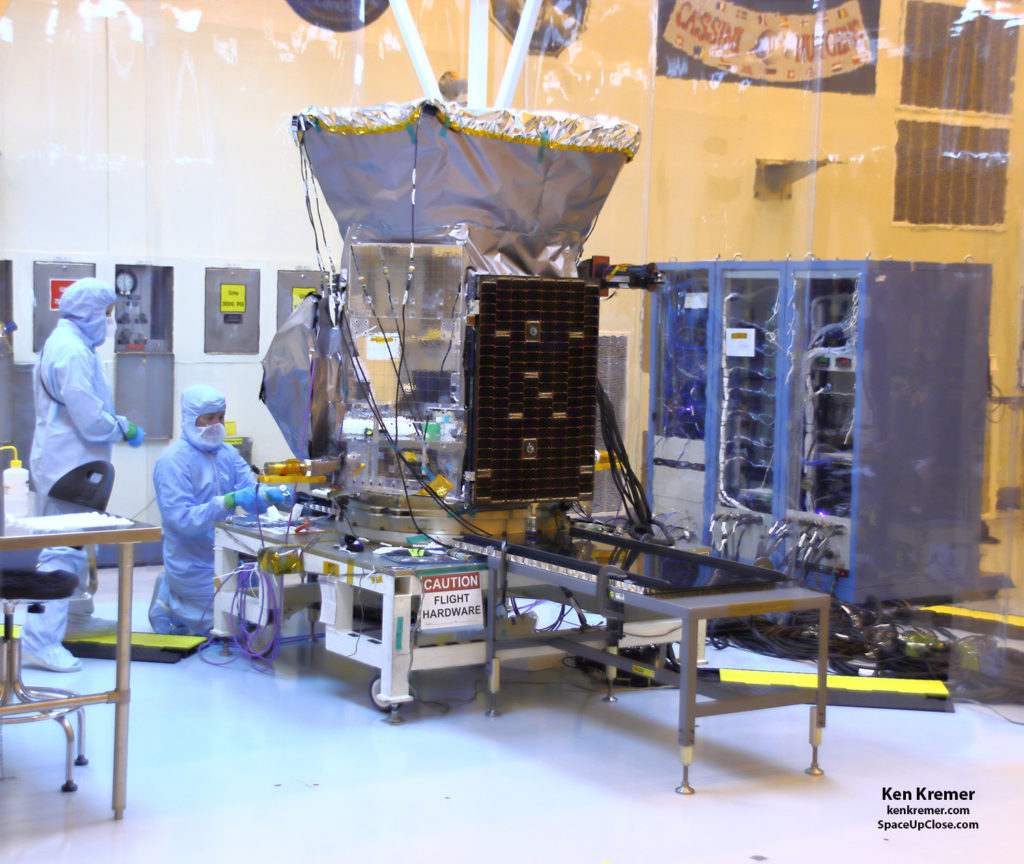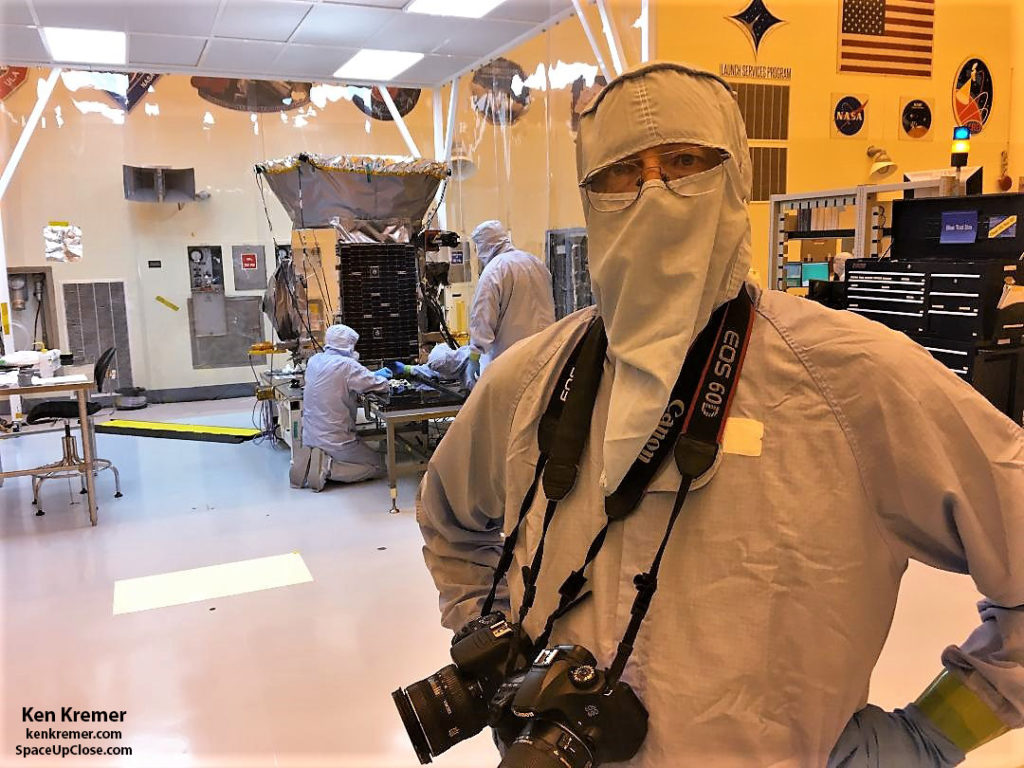 |
|
Artist’s concept of NASA’s Orbital
ATK-built Transiting Exoplanet Survey Satellite (TESS) planet hunting satellite orbiting the Earth-Moon system. Credit: NASA/Orbital ATK |
Ken Kremer — SpaceUpClose.com — 13 May 2018
CENTER, FL – NASA’s recently launched TESS planet hunting probe is healthy,
operating very well, and more than halfway through the demanding regimen of on
board thruster firings required to carry out the preplanned series of six orbit
raising maneuvers setting up this weeks do or die Lunar Flyby trajectory
adjustment on May 17 – absolutely critical to reaching its intended science perch,
Orbital ATK TESS program manager Robert Lockwood told
SpaceUpClose.com in an interview.
all sky survey and discover dozens of new Earth and Super Earth sized
exoplanets beyond our Solar System that may be capable of supporting life, and
possibly answer one of humanities most profound questions – “Are We Alone?”
Robert Lockwood told SpaceUpClose.com in an exclusive interview. Lockwood is based at the TESS mission
operations center at Orbital ATK headquarters in Dulles, VA.
raising and adjustment] thruster firing maneuvers.”
we have the flyby of the Moon on Wednesday night /early Thursday May 17 … that
will change the orbit significantly ..
and get in position … to do a
period adjustment to get into the special ‘goldilocks’ orbit – the P/2 lunar
resonant orbit.”
UTC on 17 May 2018 at a distance of approximately 8000 kilometers altitude
above the surface.
Lockwood.
built by prime contractor Orbital ATK.
mission and a follow up to the hugely successful Kepler probe which discovered
over 2300 exoplanets of all sizes.
engineering and science teams are diligently working through the middle of the
commissioning phase activities.
commissioning timeline,” Lockwood told me.
770 pounds (350 g) and measures 12 x 4 x 5 ft (3.7 x 1.2 x 1.5 m).
sunset blastoff to space from the Florida Space Coast on April 18 aboard a
SpaceX Falcon 9 rocket NASA’s newest exoplanet
hunting spacecraft is in fine shape and on course to achieve its very special
mission enabling P/2 lunar resonant orbit.
Survey Satellite (TESS) successfully blasted off on a two stage SpaceX Falcon 9
rocket at 6:51 p.m. EDT, April 18, from seaside Space Launch Complex-40 on Cape
Canaveral Air Force Station, Florida.
six thruster burns to travel in a series of progressively elongated orbits to
reach the Moon – which will provide a gravitational assist so that TESS can
transfer into its 13.7-day P/2 lunar resonant final science orbit – a highly
elliptical orbit around Earth.
 |
|
Graphic of NASA’s
Transiting Exoplanet Survey Satellite orbit raising maneuvers. Credit: NASA |
days of check-out and instrument testing, the spacecraft will begin its important
work.
spacecraft status?
L plus 5 days after launch,” Lockwood explained.
the spacecraft checkout? Is everything going as planned?
commissioning timeline.”
functionalities including power, thermal control, attitude control, propulsion,
etc.”
primarily to do their part to check out the cameras and make the measurements
they want to make on orbit.”
cameras were powered on on April 30. They were slowly cooled
to their operating temperature of -85°C.
instrument. We have about 7 weeks until we are in the final science orbit.”
spacecraft is equipped with 4 identical wide-field science cameras. Their combined field of view will enable the
spacecraft to image some 85% of the entire sky during the full sky survey over
the first two years of the primary mission phase.
with four 16.8 megapixel CCD’s and a seven element optical system.
of the kitchen table sized spacecraft inside a protective sunshade to shield
the instruments.
cameras were collecting data as of May 9.
camera check-out phase has started!
and lunar flyby?
by the Moon and then do a period adjustment to get into the special
‘goldilocks’ orbit, P/2 lunar resonant orbit,” Lockwood explained.
firing [orbit raising] maneuvers.”
we did a calibration maneuver 3 days after launch. Then we raised the apogee to
the level of the moon about a week after launch.”
we did a small timing adjustment maneuver about 2 weeks after.”
first two firings were called the first apogee maneuver (A1M) and the first
perigee maneuver (P1M) and were conducted on 22 and 25 April respectively.
we have what’s called a B plane targeting maneuver to get to a specific spot to
flyby the moon – [completed Sunday].”
we have the flyby of the Moon Wednesday night/early Thursday May 17.”
in 3 weeks time we have the period adjust maneuver to get into the P/2 orbit.”
we go through one P/2 orbit for commissioning.”
that we begin the science phase in the P/2 orbit on June 12. It’s all gone very well.”
lunar flyby?
the mission design. The lunar flyby will put us in an orbit that’s inclined to
the ecliptic by about 35 degrees,” Lockwood stated.
of GEO. So we’ll be at about 17 Earth radii for the perigee and 70 Earth radii
for the apogee.”
lower the apogee to about 59 Earth radii.”
will put TESS in exact resonance with the Moon.”
Can you describe the engine firings in detail?
one central delta V thruster on the spacecraft,” Lockwood elaborated.
lasted 449 seconds and that raised the apogee from 275,000 km to 350,000 km.”
second targeting maneuver were both very short firings.”
after we have flown past the moon [lunar flyby]. It will be about a 15 minute
burn on May 30.”
a 22 newton thruster.”
which has an apogee of 350,000 km. So its out at the distance to the moon about
57 Earth radii. The perigee is about 800
km altitude.”
begin?
about 7 weeks.”
when the science gathering begins.”
checkout review.
Goddard in Maryland on June 4 of the spacecraft, instruments and associated
ground systems. They will check that all three of those elements are ready to
proceed into mission operations.”
Falcon 9 launch itself went extremely well and injected TESS into its intended
orbit using so little fuel that the science gathering can go on for “decades”
if the spacecraft survives.
Spacecraft
checkout began soon after launch.
usage?
needed only 1/3 of the fuel on board,” Lockwood told me.
“So there is enough fuel on board for many decades of use!”
all gone very well.”
to the highly elliptical Earth orbit never used before by a science mission, said George Ricker, TESS principal investigator at the
Massachusetts Institute of Technology’s (MIT) Kavli Institute for Astrophysics
and Space Research in Cambridge Ricker at a prelaunch media
briefing.
in a 2:1 resonance orbit with the moon. The moon orbits earth every 28 days.
stable as a result, thus requiring minimal fuel to maintain. The spacecraft was intentionally loaded with
enough propellants to continue its observations for 20 years or more if all
goes well with the spacecraft systems.
for decades of exploration, TESS will search for new Earths beyond the confines
of our Solar System on a first-of-its-kind mission to
find worlds that could potentially support life.
expected to find thousands of new exoplanets orbiting nearby stars.
gathered by TESS hope to discover on the order of 300 to 500 Earths and Super
Earths alone, orbiting in their habitable zones compared to a dozen or so by
Kepler.
orbits and sizes of these exoplanets.
They will also provide the specific targets for follow up high
resolution investigations by NASA’s James Webb Space Telescope and other telescopes
to determine the exoplanets masses, compositions and atmospheric constituents.
to determine if any of the newly discovered Earths and Super Earths are actually Earth-like possessing water, oxygen and carbon based molecules for
example that can potentially support life.
discover worlds we have yet to imagine, worlds that could possibly be
habitable, or harbor life,” said Thomas Zurbuchen, associate administrator of
NASA’s Science Mission Directorate in Washington, in a statement.
Telescope to help us study the details of these planets, we are ever the closer
to discovering whether we are alone in the universe.”
critical piece for the science return of TESS is the high data rate associated
with its orbit,” said Ricker in a statement. “Each
time the spacecraft passes close to Earth, it will transmit full-frame images
taken with the cameras. That’s one of the unique things TESS brings that was
not possible before.”
divided the sky into 26 sectors. TESS will use its four unique wide-field
cameras to map 13 sectors encompassing the southern sky during its first year
of observations and 13 sectors of the northern sky during the second year,
altogether covering 85 percent of the sky.
Astrophysics Explorer mission led and operated by MIT and managed by
Goddard. George Ricker, of MIT’s Kavli Institute for Astrophysics and Space
Research, serves as principal investigator for the mission. TESS’s four
wide-field cameras were developed by MIT’s Lincoln Laboratory. Additional
partners include Orbital ATK, NASA’s Ames Research Center, the
Harvard-Smithsonian Center for Astrophysics, and the Space Telescope Science
Institute. More than a dozen universities, research institutes and
observatories worldwide are participants in the
mission.
SpaceX, ULA, Boeing, Lockheed Martin, Orbital ATK and more space and mission
reports direct from the Kennedy Space Center and Cape Canaveral Air Force
Station, Florida.
Earth and Planetary science and human spaceflight news: www.kenkremer.com –www.spaceupclose.com –
twitter @ken_kremer – ken
at kenkremer.com









